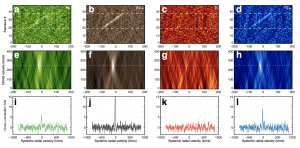Title: Atomic iron and titanium in the atmosphere of the exoplanet KELT-9b
Authors: H. Jens Hoeijmakers, David Ehrenreich, Kevin Heng, Daniel Kitzmann, Simon L. Grimm, Romain Allart, Russell Deitrick, Aurelien Wyttenbach, Maria Oreshenko, Lorenzo Pino, Paul B. Rimmer, Emilio Molinari, Luca Di Fabrizio
First Author’s Institution: Observatoire astronomique de l’Université de Genève
Status: Accepted, closed access
Ultra-hot Jupiters are the new showstoppers in the field of exoplanets. Commonly detected by ground-based wide-angle surveys (like WASP, KELT and MASCARA), they are mostly nestled in tightly close orbits around bright early-type stars which irradiate the upper atmospheres of these planets to equilibrium temperatures of more than 2000 K – as hot as the photospheres of some of the cooler stars. However, these planets are less massive than cool stars. A combination of their lower surface gravities (as compared to that of stars) and the high equilibrium temperature of ultra-hot Jupiters leads to some exotic chemistry in their atmospheres. One direct consequence of their scorching hot temperatures is that their atmospheres can be treated as systems in chemical equilibrium, and most likely cloud free as it is likely that any possible cloud condensates would be thermally dissociated at these temperatures. This makes life much easier for astronomers studying exoplanet atmospheres. As predicted by recent studies, atmospheres of ultra-hot Jupiters should have metals like iron and titanium existing in their atomic form (molecular compounds like oxides are thermally dissociated at such high temperatures). Today’s paper reports the first detection of atomic iron and titanium in the atmosphere of one such ultra-hot Jupiter: KELT-9b.
Looking at exoplanet atmospheres in high resolution
One of the ways astronomers attempt to characterize the atmosphere of an exoplanet is by measuring a very high-resolution spectrum of the exoplanetary system (see this recent review for more detail about the method). “High-resolution” in this context usually means something of the order of Δλ/λ ~ 104 to 106. In contrast to other low-resolution methods (like transmission spectroscopy, which measures broad spectral features of atmospheric chemical species), this technique gives us a dense forest of spectral lines corresponding to chemical species absorbing or emitting in the atmosphere of the planet (and also the star, since we actually measure a high-resolution spectrum of the system). A collection of a large number of spectrally resolved lines effectively acts as a chemical barcode for the exoplanetary atmosphere.
As a close-in planet (like a hot Jupiter) orbits its star, the spectral lines from the planet are Doppler shifted with respect to the stellar spectra. For this fast-moving planet (with a typical speed of 100 km/s around its stars), the magnitude of Doppler shift is strong enough that it can be used to disentangle the planet’s contribution to the measured spectrum, which is a combination of spectra from the planet, the star, and the earth’s atmosphere. Moreover, the planetary spectral lines carry an imprint of the planet’s atmospheric composition, structure, and dynamics. This is interpreted by cross-correlating the high-resolution atmospheric models with the measured spectra (also described in more detail in this astrobite). In essence, this technique involves moving a grid of high-resolution model spectra corresponding to different physical parameters of the atmosphere (chemical abundances, atmospheric structure, clouds etc.) along the measured spectra in the wavelength (or velocity) space, and hence collating the information about the overlap between the model and measured spectral lines into one 2D cross-correlation profile (as shown in Figure 1). The strength of cross-correlation function for a model represents how well it matches the observed planetary spectra.

Figure 1: a–d: Two-dimensional cross-correlation functions corresponding to model spectra for templates with neutral iron (Fe), singly-ionized iron (Fe+), neutral titanium (Ti) and singly-ionized titanium (Ti+): the absorption spectrum from the contribution of exoplanetary atmosphere shows up as bright streaks. The horizontal dashed lines mark the start and end of the planetary transit. e–h: The data co-added, along with each streak, in the rest frame of the exoplanet. i–l: The cross-correlation signal-to-noise ratio estimated the orbital velocity of the planet. Fe, Fe+ and Ti+ are clearly detected, but Ti is not. The horizontal and vertical dotted lines denote the expected orbital velocity of KELT-9b and the systemic velocity of the KELT-9 system, respectively. Figure 3 in the paper.
The extraordinary case of KELT-9b
KELT-9b is one hot Jupiter that just can’t fail to grab your attention. With an exceptionally high equilibrium temperature of ~4000 K, it’s one of the hottest hot Jupiters detected to date. Authors of today’s paper specifically conduct a search for neutral and singly ionized forms iron and titanium in the optical (~400 to 700 nm) high-resolution spectra of the KELT-9 system measured by the HARPS-N spectrograph. Assuming chemical equilibrium, the relative abundances of neutral and singly ionized iron and titanium can vary by many orders of magnitude in the range of planetary equilibrium temperatures from 2500 to 6000 K, and this makes KELT-9b one of the best candidates to hunt for the spectral signatures of these elements. Another crucial aspect in the context of ultra hot Jupiter atmospheres is the contribution of H- ions to the absorption in optical wavelengths, which was recently shown to have a significant impact on the spectral continuum of the atmosphere. The authors thus normalize their model spectra to the spectral continuum, predominantly determined by the H- absorption in the exoplanet’s atmosphere. The possibility of this normalization (which essentially means pegging the model spectra to a reference point which is the H- continuum) enables them to assign relative weights to different spectral lines with respect to the continuum, which consequently improves the signal to noise of the cross-correlation (as weaker lines with respect to the continuum now have smaller weights).
The varying line-of-sight rotational velocity of the star during the planetary transit has a distinct contribution to the measured spectrum. This is because the planet crosses regions of the stellar disk which, as the star rotates, are moving towards or away from the observer at about the same order of magnitude of velocity as the planet. The authors correct for the stellar rotation contribution before performing the cross-correlation of measured spectra with the model spectra. And voilà! As shown in Figure 1, agreeing with the theoretical predictions, they obtain significant detection peaks in the cross-correlation functions for Fe, Fe+, and Ti+, but not for Ti.
In addition to this being the first ever detection of iron and titanium in the atmosphere of an exoplanet, this result makes KELT-9b (and other ultra-hot Jupiters in its league) an important contender for similar follow-up high-resolution searches for carbon monoxide and water in the near-infrared wavelengths (which is where they have the strongest spectral features). Detection of carbon monoxide and water is key to constraining the metallicity (abundance ratio of elements heavier than hydrogen with respect to hydrogen abundance) of the atmosphere. It will also be quite helpful in discerning between carbon rich and carbon poor nature of the planetary atmosphere, which is important in the context of planet formation studies.




